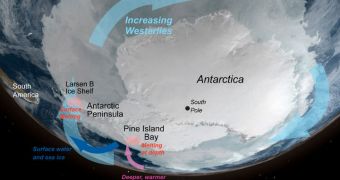More than a decade ago, two major Antarctic ice shelves collapsed into the waters of the Southern Ocean, in an event that marked the seriousness of global warming with a real-life event. Now, experts are beginning to understand how various factors conspired to underlie the collapse.
The western parts of Antarctica are losing most ice of the entire continent. The eastern parts withstood the effects of warming the longest, but even they are currently beginning to heat up.
Experts say that most at risk is a group of ice shelves on the Antarctic Peninsula, collectively called Larsen, and which began to become destabilized in the early 1990s. The effects of this instability made themselves felt very fast.
Larsen A was the first ice shelve to give away, collapsing in 1995, followed by the massive Larsen B in 2002. At this time, only the vast Larsen C endures, alongside a small portion of Larsen B.
At a presentation made in San Francisco on December 15, at the 2010 annual fall meeting of the American Geophysical Union (AGU), researchers began presenting the factors that contributed to this.
These new discoveries, which are expected to significantly improve sea level rise forecast abilities, also shed more light on the interplay between the various culprits at work here, both under and above water.
The analysis was conducted by glaciologist Ted Scambos, who holds an appointment at the Boulder, Colorado-based US National Snow and Ice Data Center (NSIDC).
“Scambos and colleagues tracked elevation information using data from satellites such as NASA's Ice, Cloud and land Elevation Satellite (ICESat) and previous airborne missions,” a new NASA press release says.
“They show that between 2001 and 2006, glaciers feeding Larsen A and Larsen B lost 12 gigatons of ice loss per year, or 30 percent of all ice lost throughout the Peninsula,” it adds.
“Moreover, the continued draw down of glaciers, such as Drygalski Glacier, fifteen years after the loss of Larsen A, have set precedent for what to expect elsewhere. Losses by glaciers that fed the Larsen B, such as Crane Glacier, are likely to continue,” the document reads.
At this point, the NSIDC expert and his colleagues are investigating shelf break-up and the onset of ice acceleration in exquisite detail, thanks to a newly-installed array of sensors, and to constant aerial observations of the entire area.
The new study suggests that the atmosphere, the ocean and ice sheets interact in a way that threatens the integrity of the glaciers. Certain winds push warm oceanic water right below the ices, where elevated temperatures wreak havoc at the point where the glaciers connect to the shoreline.
“In short, ice shelves are affected by what winds are doing. As Antarctic Circumpolar winds continue to increase, ice shelves are at increasing risk,” explains Goddard Earth Sciences and Technology Center glaciologist Bob Bindschadler.
He is based at the American space agency's Goddard Space Flight Center (GSFC), in Greenbelt, Maryland.

 14 DAY TRIAL //
14 DAY TRIAL //